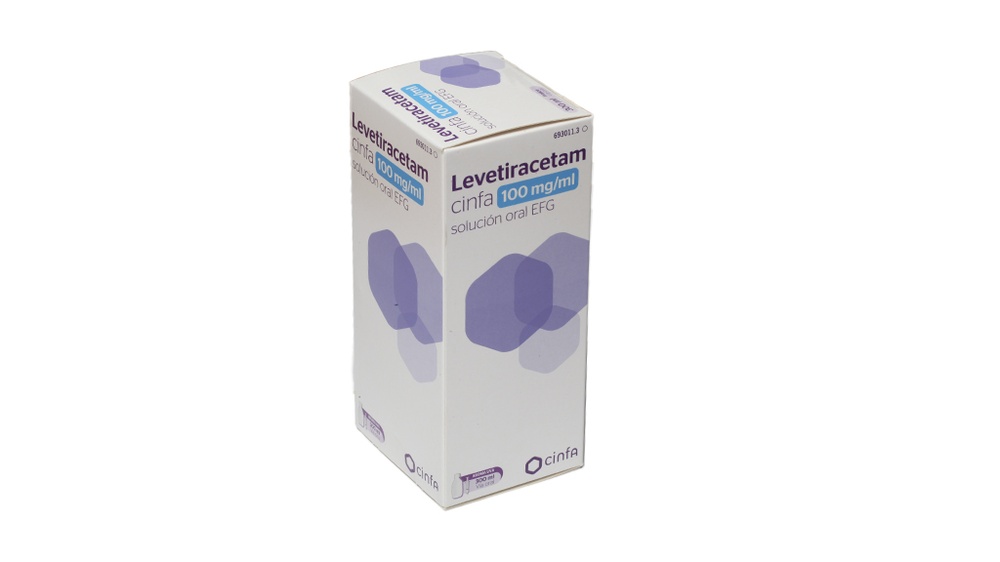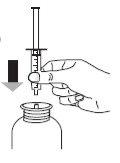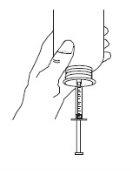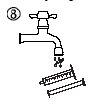

LEVETIRACETAM CINFA 100 MG/ML ORAL SOLUTION

Ask a doctor about a prescription for LEVETIRACETAM CINFA 100 MG/ML ORAL SOLUTION

How to use LEVETIRACETAM CINFA 100 MG/ML ORAL SOLUTION
Introduction
Package Leaflet: Information for the Patient
levetiracetam cinfa 100 mg/ml oral solution EFG
Read the entire package leaflet carefully before you or your child starts taking this medicine, as it contains important information for you.
- Keep this package leaflet, as you may need to read it again.
- If you have any further questions, ask your doctor or pharmacist.
- This medicine has been prescribed to you only. Do not pass it on to others. It may harm them, even if their symptoms are the same as yours.
- If you experience any side effects, talk to your doctor or pharmacist. This includes any possible side effects not listed in this package leaflet. See section 4.
Contents of the Package Leaflet
- What is levetiracetam cinfa and what is it used for
- What you need to know before taking levetiracetam cinfa
- How to take levetiracetam cinfa
- Possible side effects
- Storage of levetiracetam cinfa
- Contents of the pack and further information
1. What is levetiracetam cinfa and what is it used for
Levetiracetam is an antiepileptic medicine (a medicine used to treat seizures in epilepsy).
Levetiracetam cinfa is used:
- alone in adults and adolescents from 16 years of age with newly diagnosed epilepsy to treat a form of epilepsy. Epilepsy is a disease where patients have seizures. Levetiracetam is used for the form of epilepsy where the seizures initially affect only one side of the brain but can later spread to larger areas on both sides of the brain (partial onset seizures with or without secondary generalization). Your doctor has prescribed levetiracetam to reduce the number of seizures.
- in combination with other antiepileptic medicines to treat:
- partial onset seizures with or without secondary generalization in adults, adolescents, children, and infants from 1 month of age.
- myoclonic seizures (short, shock-like jerks of a muscle or group of muscles) in adults and adolescents from 12 years of age with juvenile myoclonic epilepsy.
- primary generalized tonic-clonic seizures (major seizures, including loss of consciousness) in adults and adolescents from 12 years of age with idiopathic generalized epilepsy (a type of epilepsy thought to have a genetic cause).
2. What you need to know before taking levetiracetam cinfa
Do not take levetiracetam cinfa
If you are allergic to levetiracetam, to pyrrolidone derivatives, or to any of the other ingredients of this medicine (listed in section 6).
Warnings and precautions
Talk to your doctor before taking levetiracetam cinfa.
- If you have kidney problems, follow your doctor's instructions, who will decide if you need to adjust the dose to be taken.
- If you notice any decrease in your child's growth or an unexpected development of puberty, contact your doctor.
- A small number of people being treated with antiepileptics such as levetiracetam cinfa have had thoughts of harming themselves or committing suicide. If you have any symptoms of depression and/or suicidal thoughts, contact your doctor.
Tell your doctor or pharmacist if any of the following side effects get worse or last more than a few days:
- Abnormal thoughts, feeling irritable, or reacting more aggressively than usual, or if you or your family and friends notice significant changes in your mood or behavior.
Children and adolescents
- Monotherapy with levetiracetam (single treatment) is not indicated in children and adolescents under 16 years of age.
Using levetiracetam cinfa with other medicines
Tell your doctor or pharmacist if you are taking, have recently taken, or might take any other medicines.
Do not take macrogol (a medicine used as a laxative) for one hour before and one hour after taking levetiracetam, as it may reduce its effect.
Taking levetiracetam cinfa with food, drinks, and alcohol
You can take levetiracetam with or without food. As a safety precaution, do not take levetiracetam with alcohol.
Pregnancy and breastfeeding
If you are pregnant or breastfeeding, think you may be pregnant, or plan to become pregnant, consult your doctor before using this medicine. Levetiracetam can only be used during pregnancy if, after careful evaluation, your doctor considers it necessary.
Do not stop your treatment without discussing it with your doctor first.
The risk of birth defects for the baby cannot be completely excluded. Breastfeeding is not recommended during treatment.
Driving and using machines
Levetiracetam may cause symptoms such as drowsiness, dizziness, or changes in vision, and may decrease your reaction ability. These effects, as well as the disease itself, may make it difficult for you to drive vehicles or operate machines. Therefore, do not drive, operate machines, or engage in other activities that require special attention until your doctor assesses your response to this medicine.
Levetiracetam cinfa contains methyl parahydroxybenzoate and propyl parahydroxybenzoate.
It may cause allergic reactions (possibly delayed) because it contains methyl parahydroxybenzoate (E-218) and propyl parahydroxybenzoate (E-216).
Levetiracetam cinfa contains liquid maltitol.
This medicine contains liquid maltitol (E-965). If your doctor has told you that you have an intolerance to certain sugars, consult them before taking this medicine.
Levetiracetam cinfa contains sodium.
This medicine contains less than 23 mg of sodium (1 mmol) per ml; i.e., it is essentially "sodium-free".
3. How to take levetiracetam cinfa
Follow the administration instructions of this medicine exactly as indicated by your doctor or pharmacist. If in doubt, consult your doctor or pharmacist again.
Levetiracetam cinfa should be taken twice a day, once in the morning and once in the evening, approximately at the same time each day.
Take the oral solution according to your doctor's instructions.
Monotherapy
Dose in adults and adolescents (from 16 years of age):
For patients from 4 years of age, measure the correct dose using the 10 ml syringe included in the package.
General dose: levetiracetam cinfa is taken twice a day, in two equal doses, each individual dose between 5 ml (500 mg) and 15 ml (1500 mg).
When starting levetiracetam cinfa, your doctor will prescribe a lower dosefor two weeks before administering the lowest general dose.
Concomitant therapy
Dose in adults and adolescents (from 12 to 17 years):
For patients from 4 years of age, measure the correct dose using the 10 ml syringe included in the package.
General dose: levetiracetam cinfa is taken twice a day, in two equal doses, each individual dose between 5 ml (500 mg) and 15 ml (1500 mg).
Dose in children from 6 months of age:
Your doctor will prescribe the most suitable pharmaceutical form of levetiracetam cinfa according to age, weight, and dose.
For children from 6 months to 4 years of age, measure the correct dose using the 3 mlsyringe included in the package.
For children over 4 years of age, measure the correct dose using the 10 mlsyringe included in the package.
General dose: levetiracetam cinfa is taken twice a day, in two equal doses, each individual dose between 0.1 ml (10 mg) and 0.3 ml (30 mg) per kilogram of the child's body weight (see the following table for examples of doses).
Dose in children from 6 months of age:
Weight | Initial dose: 0.1 ml/kg twice a day | Maximum dose: 0.3 ml/kg twice a day |
6 kg | 0.6 ml twice a day | 1.8 ml twice a day |
8 kg | 0.8 ml twice a day | 2.4 ml twice a day |
10 kg | 1 ml twice a day | 3 ml twice a day |
15 kg | 1.5 ml twice a day | 4.5 ml twice a day |
20 kg | 2 ml twice a day | 6 ml twice a day |
25 kg | 2.5 ml twice a day | 7.5 ml twice a day |
From 50 kg | 5 ml twice a day | 15 ml twice a day |
Dosing in infants (from 1 month to less than 6 months):
For infants from 1 month to less than 6 months of age, measure the correct dose using the 1 mlsyringe included in the package.
General dose: levetiracetam cinfa is taken twice a day, in two equal doses, each individual dose between 0.07 ml (7 mg) and 0.21 ml (21 mg) per kilogram of the infant's body weight (see the following table for examples of doses).
Dose in infants (from 1 month to less than 6 months of age):
Weight | Initial dose: 0.07 ml/kg twice a day | Maximum dose: 0.21 ml/kg twice a day |
4 kg | 0.3 ml twice a day | 0.85 ml twice a day |
5 kg | 0.35 ml twice a day | 1.05 ml twice a day |
6 kg | 0.45 ml twice a day | 1.25 ml twice a day |
7 kg | 0.5 ml twice a day | 1.5 ml twice a day |
Method of administration:
After measuring the correct dose with the suitable syringe, levetiracetam cinfa can be diluted in a glass of water or in a baby bottle. You can take levetiracetam with or without food. After oral administration of levetiracetam, its bitter taste may be noticed.
Instructions for correct administration:
- Open the bottle: press the cap and unscrew it counterclockwise (figure 1)

Insert the adapter into the neck of the bottle (figure 2). Make sure it is securely fixed.

Take the syringe and insert it into the adapter opening (figure 3) Put the bottle upside down (figure 4)




Fill the syringe with a small amount of solution by lowering the plunger (figure 5A) and then raising it to eliminate any possible bubbles (figure 5B). Lower the plunger to the graduation mark that corresponds to the dose in milliliters (ml) prescribed by your doctor (figure 5C).

Put the bottle upright (figure 6A). Remove the syringe from the adapter (figure 6B).

Empty the contents of the syringe into a glass of water or a baby bottle, lowering the plunger to the end of the syringe (figure 7).

Drink the entire contents of the glass or baby bottle.
- Close the bottle with the plastic screw cap.
- Wash the syringe only with water (figure 8).

Duration of treatment:
- Levetiracetam cinfa is used as a chronic treatment. You should continue treatment with levetiracetam cinfa for the time indicated by your doctor.
- Do not stop your treatment without your doctor's recommendation, as your seizures may increase.
If you take more levetiracetam cinfa than you should:
The possible side effects of an overdose of levetiracetam cinfa are drowsiness, agitation, aggression, decreased alertness, respiratory inhibition, and coma.
Contact your doctor if you have taken more oral solution than you should. Your doctor will establish the best possible treatment for the overdose.
In case of overdose or accidental ingestion, consult your doctor or pharmacist immediately or call the Toxicology Information Service, phone 91 562 04 20, indicating the medicine and the amount ingested.
If you forget to take levetiracetam cinfa
Contact your doctor if you have missed one or more doses. Do not take a double dose to make up for the missed doses.
If you stop treatment with levetiracetam cinfa
Stopping treatment with levetiracetam cinfa should be done gradually to avoid an increase in seizures. If your doctor decides to stop your treatment with levetiracetam cinfa, they will give you instructions for gradual withdrawal of levetiracetam.
If you have any further questions about the use of this medicine, ask your doctor or pharmacist.
4. Possible Adverse Effects
Like all medicines, this medicine can cause adverse effects, although not all people suffer from them.
Tell your doctor immediately, or go to the emergency department of your nearest hospital if you experience:
- weakness, dizziness, or difficulty breathing, as these may be signs of a severe allergic reaction (anaphylaxis)
- swelling of the face, lips, tongue, or throat (Quincke's edema)
- flu-like symptoms and rash on the face followed by a prolonged rash with high temperature, elevated liver enzyme levels in blood tests, and an increase in a type of white blood cells (eosinophilia) and enlarged lymph nodes (Drug Reaction with Eosinophilia and Systemic Symptoms (DRESS)
- symptoms such as low urine output, fatigue, nausea, vomiting, confusion, and swelling of legs, arms, or feet, as these may be signs of sudden renal function decrease
- a skin rash that can form blisters and may appear as small targets (dark central spots surrounded by a paler area, with a dark ring around the edge) (erythema multiforme)
- a widespread rash with blisters and skin peeling, especially around the mouth, nose, eyes, and genitals (Stevens-Johnson syndrome)
- a more severe form that causes skin peeling on more than 30% of the body surface (toxic epidermal necrolysis)
- signs of severe mental changes or if someone around you notices signs of confusion, drowsiness (drowsiness), amnesia (memory loss), memory impairment (forgetfulness), abnormal behavior, or other neurological signs including involuntary or uncontrolled movements. These may be symptoms of encephalopathy.
The most frequently reported adverse effects are nasopharyngitis, drowsiness (feeling of sleep), headache, fatigue, and dizziness. Adverse effects such as feeling of sleep, feeling of weakness, and dizziness may be more frequent when treatment is initiated or the dose is increased. However, these adverse effects should decrease over time.
Very common:may affect more than 1 in 10 patients
- nasopharyngitis;
- drowsiness (feeling of sleep), headache.
Common:may affect up to 1 in 10 patients
- anorexia (loss of appetite);
- depression, hostility or aggression, anxiety, insomnia, nervousness or irritability;
- seizures, balance disorder, dizziness (feeling of instability), lethargy (lack of energy and enthusiasm), tremor (involuntary tremor);
- vertigo (feeling of rotation);
- cough;
- abdominal pain, diarrhea, dyspepsia (heavy digestion, burning, and acidity), vomiting, nausea;
- skin rash;
- asthenia/fatigue (feeling of weakness).
Uncommon:may affect up to 1 in 100 patients
- decrease in platelet count, decrease in white blood cells;
- weight loss, weight gain;
- suicidal attempt and suicidal thoughts, mental disorders, abnormal behavior, hallucinations, anger, confusion, panic attack, emotional instability/mood changes, agitation;
- amnesia (memory loss), memory impairment (lack of memory), abnormal coordination/ataxia (altered movement coordination), paresthesia (tingling), attention disorders (loss of concentration);
- diplopia (double vision), blurred vision;
- elevated/abnormal values in liver function tests;
- hair loss, eczema, itching;
- muscle weakness, myalgia (muscle pain);
- injury.
Rare:may affect up to 1 in 1,000 patients
- infection;
- decrease in all types of blood cells;
- severe allergic reactions (DRESS, anaphylactic reaction (important and severe allergic reaction), Quincke's edema (swelling of face, lips, tongue, and throat);
- decrease in sodium concentration in blood;
- suicide, personality disorders (behavioral problems), abnormal thinking (slow thinking, difficulty concentrating);
- delirium;
- encephalopathy (see subsection "Tell your doctor immediately" for a detailed description of symptoms);
- uncontrolled muscle spasms affecting the head, torso, and limbs, difficulty controlling movements, hyperkinesia (hyperactivity);
- pancreatitis (inflammation of the pancreas);
- liver failure, hepatitis (inflammation of the liver);
- sudden decrease in renal function;
- skin rash, which can lead to blisters that may appear as small targets (dark central spots surrounded by a paler area, with a dark ring around the edge) (erythema multiforme), a widespread rash with blisters and skin peeling, especially around the mouth, nose, eyes, and genitals (Stevens-Johnson syndrome) and a more severe form that causes skin peeling on more than 30% of the body surface (toxic epidermal necrolysis);
- rhabdomyolysis (muscle tissue breakdown) and increased blood creatine phosphokinase associated. The prevalence is significantly higher in Japanese patients compared to non-Japanese patients;
- limping or difficulty walking.
Reporting of Adverse Effects
If you experience any type of adverse effect, consult your doctor or pharmacist, even if it is a possible adverse effect that does not appear in this prospectus. You can also report them directly through the Spanish Pharmacovigilance System for Human Use Medicines: https://www.notificaram.es. By reporting adverse effects, you can contribute to providing more information on the safety of this medicine.
5. Storage of Levetiracetam Cinfa
Keep this medicine out of sight and reach of children.
Do not store at a temperature above 30°C.
Store in the original packaging to protect it from light.
Do not use this medicine after the expiration date that appears on the box and on the bottle after CAD. The expiration date is the last day of the month indicated.
Do not use Levetiracetam Cinfa 100 mg/ml oral solution 2 months after opening the package.
Medicines should not be thrown away through the sewers or in the trash. Deposit the packages and medicines you no longer need in the SIGRE Point of the pharmacy. In case of doubt, ask your pharmacist how to dispose of the packages and medicines you no longer need. This way, you will help protect the environment.
6. Package Contents and Additional Information
Composition of Levetiracetam Cinfa
- The active ingredient is levetiracetam. Each ml contains 100 mg of levetiracetam.
- The other components are: sodium citrate dihydrate, citric acid monohydrate, methyl parahydroxybenzoate (E-218), propyl parahydroxybenzoate (E-216), ammonium glycyrrhizate, glycerol (E-422), liquid maltitol (E-965), acesulfame K (E-950), grape flavor, purified water.
Appearance of the Product and Package Contents
Levetiracetam Cinfa 100 mg/ml oral solution is a clear liquid.
The 300 ml glass bottle (for children from 4 years of age, adolescents, and adults)is packaged in a cardboard box with a 10 ml oral syringe (graduated every 0.25 ml) and a syringe adapter.
The 150 ml glass bottle (for infants and young children from 6 months to less than 4 years of age)is packaged in a cardboard box with a 3 ml oral syringe (graduated every 0.1 ml) and a syringe adapter.
The 150 ml glass bottle (for infants from 1 month to less than 6 months of age)is packaged in a cardboard box with a 1 ml oral syringe (graduated every 0.05 ml) and a syringe adapter.
Only some package sizes may be marketed.
Marketing Authorization Holder and Manufacturer
Marketing Authorization Holder:
Laboratorios Cinfa, S.A.
Carretera Olaz-Chipi, 10. Polígono Industrial Areta
31620 Huarte (Navarra) – Spain
Manufacturer:
Laboratorium Sanitatis, S.L.
P.T. Alava – C/ Leonardo Da Vinci, 11 01510 Miñano (Álava) - Spain
Date of the Last Revision of this Prospectus: June 2020
Detailed and updated information on this medicine is available on the website of the Spanish Agency for Medicines and Health Products (AEMPS) http://www.aemps.gob.es/
You can access detailed and updated information about this medicine by scanning the QR code included in the prospectus and packaging with your mobile phone (smartphone). You can also access this information at the following internet address: https://cima.aemps.es/cima/dochtml/p/76440/P_76440.html
QR code to: https://cima.aemps.es/cima/dochtml/p/76440/P_76440.html

How much does LEVETIRACETAM CINFA 100 MG/ML ORAL SOLUTION cost in Spain ( 2025)?
The average price of LEVETIRACETAM CINFA 100 MG/ML ORAL SOLUTION in December, 2025 is around 56.64 EUR. Prices may vary depending on the region, pharmacy, and whether a prescription is required. Always check with a local pharmacy or online source for the most accurate information.
- Country of registration
- Average pharmacy price56.64 EUR
- Active substance
- Prescription requiredYes
- Manufacturer
- This information is for reference only and does not constitute medical advice. Always consult a licensed doctor before taking any medication. Oladoctor is not responsible for medical decisions based on this content.
- Alternatives to LEVETIRACETAM CINFA 100 MG/ML ORAL SOLUTIONDosage form: INJECTABLE PERFUSION, 100 mgActive substance: levetiracetamManufacturer: Ucb PharmaPrescription requiredDosage form: INJECTABLE PERFUSION, 100 mg/mlActive substance: levetiracetamManufacturer: Ucb PharmaPrescription requiredDosage form: ORAL SOLUTION/SUSPENSION, 100 mgActive substance: levetiracetamManufacturer: Ucb PharmaPrescription required
Alternatives to LEVETIRACETAM CINFA 100 MG/ML ORAL SOLUTION in other countries
The best alternatives with the same active ingredient and therapeutic effect.
Alternative to LEVETIRACETAM CINFA 100 MG/ML ORAL SOLUTION in Poland
Alternative to LEVETIRACETAM CINFA 100 MG/ML ORAL SOLUTION in Ukraine
Online doctors for LEVETIRACETAM CINFA 100 MG/ML ORAL SOLUTION
Discuss dosage, side effects, interactions, contraindications, and prescription renewal for LEVETIRACETAM CINFA 100 MG/ML ORAL SOLUTION – subject to medical assessment and local rules.







